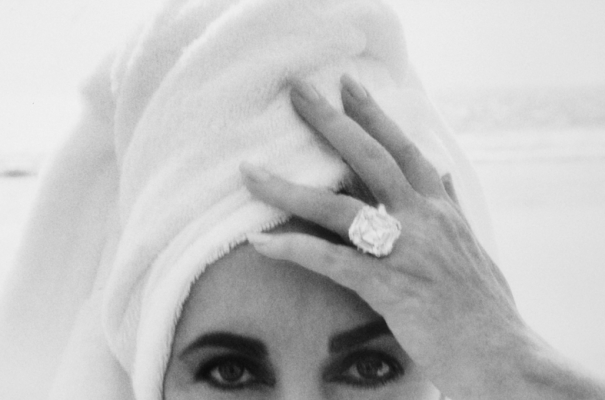
Elizabeth Taylor’s 33-carat Krupp Diamond – Photographed by Herb Ritts
On this Valentine’s Day, there will be countless men getting on their knees…to propose, that is. For most, this day marks eternal love. And if you find yourself getting engaged- surrounded by all the other cupid’s- and feel that your man decided to close the deal on such a predictable day, just smile sweetly and then stare at your rock as if you were channeling Elizabeth Taylor. In the meantime, discover why he gave you that ring and its significance as my friend- and featured guest blogger– Lorraine de Tymowska, who works for a world-renowned diamond company, wrote this very informative article originally featured on STATUS Chicago. I’m delighted to share with all.
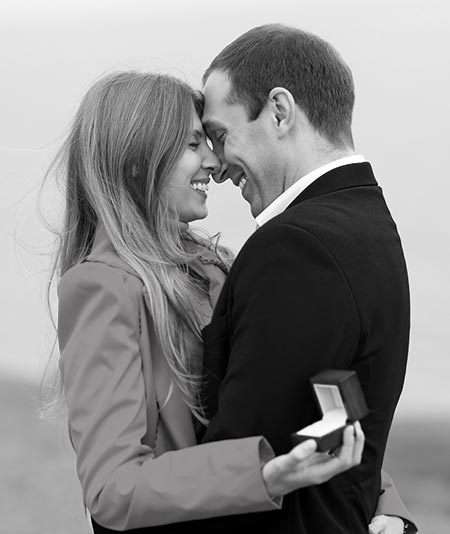
History of Engagement Rings, by Lorraine de Tymowska
Have you ever wondered why the diamond is the engagement ring of choice? Where did the idea originate? Why is a diamond the ultimate symbol of love and adoration? The use of rings as a symbol of commitment dates back through ancient history, specifically to the betrothal- truth- rings of the Romans. For them, betrothal rings were given as a sign of affection or friendship. They did not always represent the rite of marriage. The circle was used to symbolize a never ending cycle and the space inside, a gateway. In the 2nd Century, before the Christian era, it was often common that the Roman bride was given two rings, a gold one, which she wore in public, and one made of iron, which she could wear at home while doing house chores.
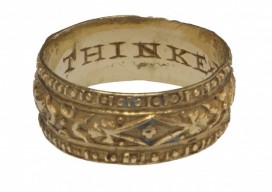
Early rings were often formed from twisted copper or braided hair. Later on came engagement rings that included a small key. Romantics believe that the carved key was a symbolic key to protect and cherish the husband’s heart. However, the key most likely stood for the unlocking of wealth. Another type of betrothal ring called posy rings emerged in the Middle Ages. Posy rings were frequently inscribed love poems and other messages. Rings of this style remained popular until the Victorian era. Prior to the tradition of choosing a mate before purchasing a ring, many men in the Middle Ages would do just the opposite. They typically kept a ring tied to their hats, and would give it to their chosen wife-to-be once she was found.
During the Renaissance period, Gimmel or twin rings were popular as well. Parts of this ring were worn by both bride-to-be and groom-to-be, and sometimes by a third party. The three parts were united on the wedding day to become the wedding ring. As for the placement of the ring on the fourth finger, it originated from a Greek belief that a vein in the fourth finger- vena amoris, translated to vein of love- ran directly to the heart. Other stories suggest that the tradition may be a reflection of the fact that the heart lies slightly left to the body.
Historically, the engagement ring originated in 1215, when Pope Innocent III established a waiting period between the promise of marriage and the actual marriage ceremony. The rings then signified the couple’s commitment and devotion to one another. Along with serving as symbols of an intention to marry, these early rings also represented social rank. Only the elite were permitted to wear ornate rings or rings with jewels. The first recorded presentation of a diamond engagement ring, the one that set the trend, was in 1477 when Archduke Maximilian of Austria proposed marriage to Mary of Burgundy. Although engagement rings were common at this time, diamonds were a rarity and thus, reserved for royalty and the elite upper class.
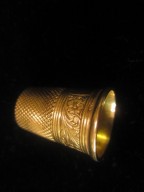
During the Colonial Period in America, a thimble was given as a sign of eternal companionship. Women would remove the tops of the thimble to create a ring. This tradition lasted until the 19th Century.
Ever since, diamonds have been widely known as the enduring universal symbol of love, romance, and commitment. This is mainly due to the fact that diamonds are beautiful, but more than just aesthetically. A diamond is strong, and durable, much like the tradition of a lasting marriage. The stone’s name is derived from the Greek work adamas, which translates to unconquerable. This symbolic meaning lends itself well to the diamond’s historic commemoration of eternal love. The earliest diamonds were found in India in the 4th Century B.C. Until the 18th Century, India was thought to be the only source of diamonds. In the late 1800’s the Kimberly Mine of South Africa was discovered, adding a major new source of mining for a rare gem.
Diamonds and rubies, signifying eternity and love, were commonly combined in rings used in the 17th and 18th Centuries. Styles also featured heart patterns, a popular symbol during that time. It is only after 1870, when several diamond mines were discovered in South Africa, that the availability and affordability of diamonds were greatly increased. Diamonds were no longer limited to only the richest and noblest families. In the 18th and 19th Centuries, colored stones still remained quite popular in engagement jewelry. Themes used in many rings would include several stones, which spelled out a word or name with the first letter of each stone. For example, dearest would be represented in a ring containing a diamond, emerald, amethyst, ruby, epidote, sapphire, and turquoise. Serpents were considered a symbol of good luck, and used in many engagement rings in the same period. Queen Victoria was given a ring using this motif.
Engagement rings did not become standard practice in the West until the end of the 19th Century. The solitaire setting was introduced as one of the most popular styles of engagement rings, while diamond rings did not become common until the 1930’s. In the late 1930’s and early 1940’s, the engagement ring became the leading line of jewelry in most department stores. The United States became the premium marketplace for high-quality diamonds, effectively making diamond engagement rings a common choice in America. In 1944, a Catholic priest asked The American Ecclesiastical Review as to whether he was permitted to marry a couple in a double ring ceremony, and if so, how to go about it. The Roman Ritual historically calls for the blessing of the bride’s ring but the Review OK’d the practice and set a modern precedent.
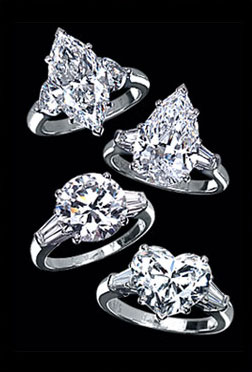
Wedding rings amongst men became more common during World War II, as the men overseas wore their rings in reminder of their wives and families back home. In the 21st Century, especially within Western civilization, it has become a common expectation for the bride-to-be to permanently wear her ring as a means to maintain their commitment. Now, approximately 80% of American women are offered a diamond ring to signify engagement. The diamond’s rarity beauty, and strength make it a fitting symbol of the resilience and longevity of marriage. With their rich history, sense of permanence, and lustrous brilliance, diamonds are a natural choice to signify a lasting union.
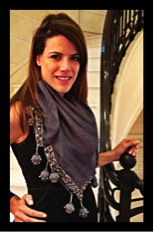
Lorraine de Tymowska is a sales executive at Graff Diamonds in Chicago; the London-based leading luxury jewelry company. She began her jewelry career interning with Christie’s Jewelry Department in Geneva, Switzerland. Afterwards, she moved to New York where she completed the Gemological Institute of America Graduate Gemologist and Jewelry Designer programs in 2007. She works closely with clients developing all stages of their jewelry collections and closely advises couples on buying engagement rings and wedding bands. Lorraine consults with clients on how to buy diamonds intelligently and as an investment, as well as sketching and designing custom pieces. Lorraine lives in Chicago with her dog, Bandit.
Tags: Culture, Fashion, Graff, Jewelry

Really enjoyed this piece! Great bit of history-thanks.